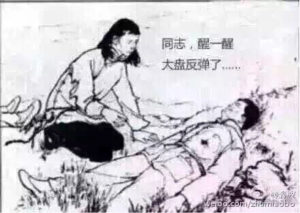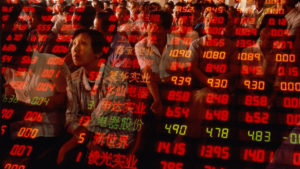On 16 JUNE 2015, the Shanghai Composite Index, a measure of the price of all stocks traded at the Shanghai Stock Exchange, reached an all-time high of 5,166 points. Share prices began falling the next day in a series of dramatic drops interrupted by occasional recoveries, dipping as low as 2,964 on 24 August and ending the year on 30 December at 3,572.
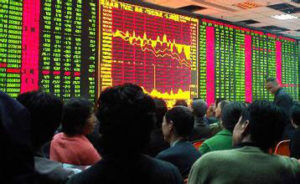
In the Chinese stock market, red indicates a gain in stock price while green indicates a loss
Source: image.baidu.com
China’s other stock markets followed the same pattern. After years of modest if sometimes sluggish growth since the 2008 global financial crisis, a season of exuberant rallies beginning in the late summer of 2014 turned stock market mania into a cultural phenomenon. According to Bloomberg, more than forty million new stock trading accounts were added between May 2014 and May 2015. The Yangcheng Evening News 羊城晚报 reported on the plight of ‘stock market widows’ 股市寡妇—women whose husbands spent all their waking hours staring at screens showing market movements. The Wuhan Evening Paper 武汉晚报 reported that one wife threatened to divorce her husband unless he invested his stock market gains in a house for their son. A man on Weibo recounted giving ninety-nine stock shares to his wife for Valentine’s Day. State media contributed to the hype, urging investors on and dismissing fears that the picture of unlimited gain was too good to be true. In April 2015, the People’s Daily article declared ‘4,000 points is just the beginning!’ As stories of small-time investors hitting it big spread, media outlets gave a name to the craze: the Stock Market Dream 股市梦, an adaptation of the government’s much vaunted ‘Chinese Dream’.
The major cause of the frenetic trading activity was probably the easing of restrictions on trading with borrowed money (known as margin financing). Following a pilot program in 2010, the Chinese Securities Regulatory Commission (CSRC) 中国证券监督管理委员会 sanctioned this practice in 2011, but restricted it to investors who had maintained an account with a registered securities company for at least eighteen months, with the value of cash and stock in the account of at least RMB 500,000. But it loosened requirements in 2013. As stock prices rose, inexperienced individual investors borrowed money, driven by the fear of missing out on the opportunity to get rich quick. In stock markets like those of Shanghai and Shenzhen, which are dominated not by institutional investors but individual retail investors with a taste for speculation, this can lead to instability.
In early June 2015, when the CSRC announced new restrictions on margin financing, the market panicked, dropping 8.5 percent in a day. Instead of rallying as predicted, though, the market kept dropping. The government responded with heavy-handed rescue measures, including propping up stocks with government funds in an unsuccessful attempt to restore investor confidence. By 8 July, the Shanghai stock index had lost thirty-two percent of its value at its peak.
Although the market failed to respond to government intervention, the government continued to react, this time punitively. On 25 August, a day after yet another market dip which newspapers around the world dubbed ‘Black Monday’, public security officials arrested Caijing journalist Wang Xiaolu 王晓璐 for ‘spreading false information’ in connection with an article he wrote claiming CSRC was planning to withdraw its support of the stock markets. A report on 30 August in the Financial Times, citing senior officials, stated that the government was in fact abandoning its attempt to prop up the markets through buying stocks—though it was evidently not abandoning its attempt to strike out against those it suspected of spreading harmful information. A few days after his arrest, Wang confessed on state television, apologising for causing ‘panic and disorder’.
To the Gallows
Throughout the summer, many Chinese Internet users responded to the stock market misery with gallows humour and satire. ‘Last month, when the market was rising, the dog ate the same as I ate. Last week, when the market fell, I ate the same as the dog ate. This week I might eat the dog,’ one joke went. In another joke, posted on Weibo, an investor boasts that one reason he survived the latest market crash is that he studied past market fluctuations, monitored economic fundamentals, and read Marx’s Das Capital. The second reason: the last market crash had already wiped out all of his savings. Some playfully counterpoised China’s mythicised past with financial market developments. Cartoons depicting ironically repurposed images of Communist liberation circulated on social media: in one, China’s SOE investment fund is portayed as brawny communist troops arriving to shore up stock prices. In another, a girl stands over a fallen solider, saying ‘Awake, comrade, the stock market is rebounding’. After more than a year of stock market mania, China’s ‘stock market dream’ had become a nightmare.
Stock Market Crash Timeline
1 April
The People’s Daily and other state media encourage investors to keep buying stocks, arguing that prices will keep rising.
12 June
Shanghai Composite Index peaks at 5,166 points.
27 June
China’s central bank, the People’s Bank of China (PBOC) cuts its benchmark lending rate to a record low and reduces reserve
requirements for some banks.
29 June
Pension funds managed by local governments are allowed to invest in the stock market, unlocking up to one billion RMB to invest in the equity market.
Stocks continue to drop. The Shanghai Composite Index drops 8.5 percent in a day.
1 July
The Shanghai and Shenzhen stock exchanges announce plans to lower securities transaction fees by thirty percent.
2 July
The Chinese Securities Regulatory Commission (CSRC) lowers the threshold for margin financing for individual investors.
The CSRC sets up a team to investigate illegal manipulation of stock prices.
4 July
China’s top twenty-one securities brokerages pledge to invest at least 120 billion RMB, or fifteen percent of their net assets, to stabilise markets.
Regulators halt new initial public offerings in an effort to shore up liquidity.
5 July
PBOC announces that it would provide liquidity support to the state-backed margin finance company, China Securities Finance Corp.
6 July
Over the course of a few days, the China Securities Finance Corp (CSF) buys at least one trillion RMB worth of shares in an effort to stabilise markets.
8 July
The Shanghai stock index plummets thirty-two percent from its peak.
9 July
The Ministry of Public Security says it will help the CSRC investigate short selling of stocks and indexes.
20 July
Caijing journalist Wang Xiaolu publishes an article claiming the CSRC plans to withdraw funds from the stock market.
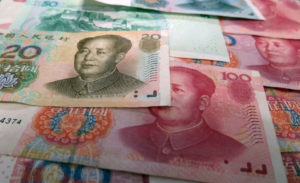
11 August 2015: China carried out the biggest devaluation of the renminbi in two decades to boost its slowing economy
Source: pixabay.com
14 August
The CSRC announces that it will allow the market to play a bigger role in determining stock prices, signalling that the government might reduce its role in propping up the markets.
24 August
Shanghai’s main share index loses 8.49 percent of its value. Xinhua—an organ not given to hyperbole when reporting bad news out of China—dubs it ‘Black Monday’.
The PBOC cuts interest rates and reserve requirement ratio for the second time.
25 August
Wang Xiaolu is detained by police. The search term ‘stock market collapse’ is censored on Baidu. The front page of the People’s Daily contains no news regarding the stock market.
30 August
The Public Security Bureau announces that it has punished 197 people as part of a ‘special campaign’ associated with ‘spreading rumours’ online about the stock market crash.
31 August
Wang Xiaolu confesses on state television to making ‘irresponsible’ and ‘sensational’ remarks in his writing about the stock market.
14 September
Biggest stock price drop since August.
Notes
For further information, see David Wertime, ‘Is the Shanghai Stock Market Bubble Finally Bursting?’, 29 May 2015, online at: https://www.chinafile.com/reporting-opinion/media/shanghai-stock-market-bubble-finally-bursting; ‘Wife forces husband to sell off shares and buy apartment to dodge post-Dragon Boat Festival slump’ “老婆逼老公清仓买楼躲过端午节前暴跌”, 30 June 2015, online at: http://news.sohu.com/20150620/n415366430.shtml; and ‘Entire population is speculating more frantically than in ’06 — a reminder: not everyone makes money’ “全民炒股比06年更疯狂 提醒:不是人人赚钱”, 25 April 2015, online at: http://finance.sina.com.cn/money/lczx/20150425/140222044420.shtml
Austin Ramzy, ‘Plunge in Chinese Stocks Leads to Bull Market for Gallows Humor’, The New York Times, 8 July 2015, online at: http://sinosphere.blogs.nytimes.com/2015/07/08/plunge-in-chinese-stocks-leads-to-bull-market-for-gallows-humor/?rref=collection%2Fcolumn%2Fsinosphere
